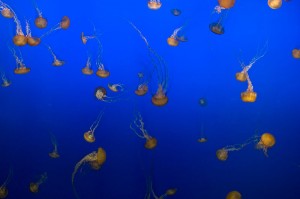 Another example of how we’re all connected: yesterday we posted about how cyanbacteria—also known as blue-green algae—has proliferated due, in part, to nitrogen and phosphorous run-off from developments. The neurotoxins produced by cyanobacteria have been implicated in some cases of Amyotrophic Lateral Sclerosis (ALS). Today in the news, they are talking about how this same nitrogen and phosphorous run-off is causing red phytoplankton blooms, “which create low-oxygen dead zones where jellyfish survive, but fish can’t.” Coupled with overfishing in many of the world’s waters, we are now seeing a huge increase in the number of jellyfish, some “as big as a sumo wrestler,” like Nomura’s jellyfish of Japan.
Another example of how we’re all connected: yesterday we posted about how cyanbacteria—also known as blue-green algae—has proliferated due, in part, to nitrogen and phosphorous run-off from developments. The neurotoxins produced by cyanobacteria have been implicated in some cases of Amyotrophic Lateral Sclerosis (ALS). Today in the news, they are talking about how this same nitrogen and phosphorous run-off is causing red phytoplankton blooms, “which create low-oxygen dead zones where jellyfish survive, but fish can’t.” Coupled with overfishing in many of the world’s waters, we are now seeing a huge increase in the number of jellyfish, some “as big as a sumo wrestler,” like Nomura’s jellyfish of Japan.
The jellyfish invasion has become such a problem in coastal communities in Japan that they have begun to promote jellyfish as a food—eaten dried and salted, or as tofu or cookies—and jellyfish collagen is being touted as beneficial for the skin.
Dr Anthony Richardson of CSIRO Marine & Atmospheric Research and colleagues report on their findings of this global jellyfish proliferation in the journal Trends in Ecology and Evolution, where they say we need to take “management action” to compensate for these human activities that created the problem, in order to avoid a jellyfish dominated marine system.
They call for the reduction of overfishing and run-off. Richardson says researchers are experimenting with various methods to reduce the jellyfish population. Some are using sound waves that explode jellyfish, others are developing special nets that cut them up. Neither sounds like a very good idea to us. For one, when jellyfish are under attack or killed, they release billions of sperm or eggs which later produce millions of jellyfish at a time.
We hope that they’ll choose the smarter and more humane approach of correcting the human behavior that caused the problem in the first place; a huge reduction in fishing and the elimination of run-offs. And maybe we can reduce the incidence of ALS in the process…










0 Comments